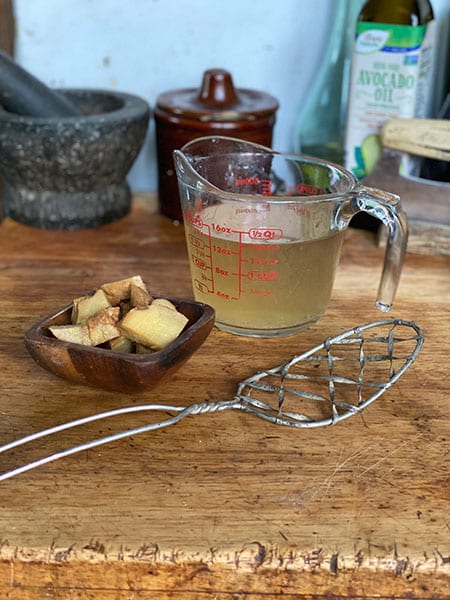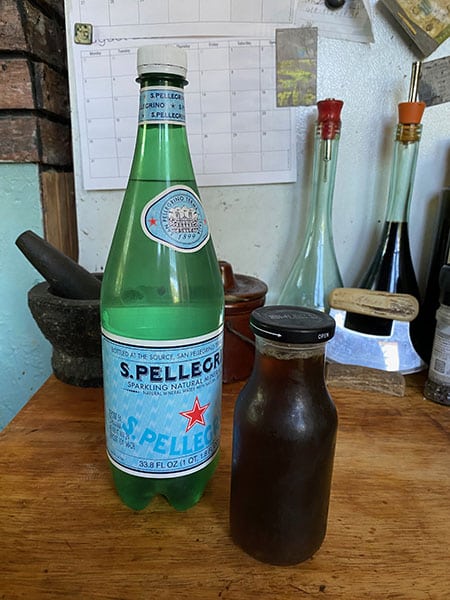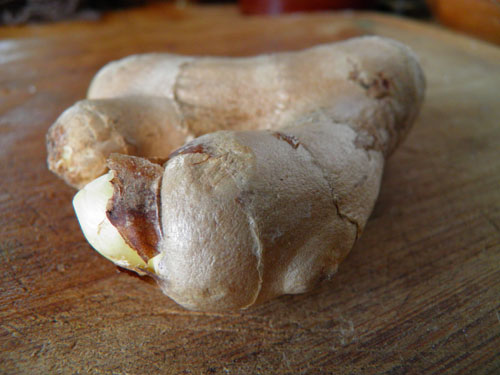Spicy and warming, Ginger is often associated with the holidays: Gingerbread houses and people and Ginger snaps are all part of traditional customs.
This warming herb is a carminative, anti-nausea, circulatory stimulant, diaphoretic, rubefacient, antispasmodic, antioxidant, antiviral, antibacterial, antifungal, antiseptic and antimicrobial.
Medicinally, Ginger…
~is best known for relieving nausea such as motion sickness, morning sickness, chemotherapy induced and postoperative
~is soothing on the digestive system and helps to stop indigestion
~aids in peripheral circulation of the body, stimulating the outer extremities
~eases the symptoms of a cold and lessens the severity of one
~reduces a fever by raising the core body temperature causing perspiration
~helps with painful flare ups caused by fibromyalgia
~relieves uterine and abdominal cramping, including irritable bowel syndrome
Ginger is a tropical plant that can be grown in temperate climates as a houseplant. It will go dormant in the winter, dying back to the rhizomes but sprouting again in late spring or early summer when temperatures and humidity are right.

Day 1:
Go over the information about Ginger. Pass around a Ginger root for your children to smell, taste and touch (look in the fresh produce section for Ginger root). Slice off a few slices and let each nibble a bit.
Ask them how they feel when they smell it (happy, sad, relaxed).
Have them nibble on a slice. As they chew it, ask them how they feel when they taste it (does their mouth dry up or do they salivate? Is it warming, cooling, HOT? Does their mouth feel refreshed?)

Day 2:
Review the uses for Ginger.
Make some Ginger Syrup. This syrup is delicious, warming and a great way to introduce kids to herbal medicine. It can be taken by the spoonful to treat sore throats, coughs, congestion, increase circulation to the outer extremities or mixed with seltzer water to make a natural Ginger ale. Try adding some to your herb tea for a sweetened kick.
If you have some extra time, you can also try making candied Ginger from the leftover Ginger pieces. (see the recipe in Day 5’s activities).
You will need:
2 cups sliced Ginger root
2 cups water
2 cups raw sugar or honey
Place ginger roots and water in a saucepan and heat to a boil. Simmer for 10 minutes then cover and let sit for one hour.
Strain off liquid from roots (roots may be frozen and used again or used for making Candied Ginger – see recipe on Day 5). Add sugar or honey to the saucepan and heat. If using sugar, bring to a boil and let boil about 5 minutes to thicken.
If using honey, gently heat while stirring to incorporate honey then shut off heat. Do not boil if using honey!
Pour into a jar and label. Store in the refrigerator for up to a month.
To make Ginger soda, mix 2 oz. Ginger syrup for every 6 oz. seltzer water.

Day 3:
Review what has been learned about Ginger. Talk about what the syrup can be used for (boosting the immune system, soothing coughs, sore throats, congestion; stimulate circulation).
Memorize or become familiar with this story and tell it:
How Ginger Got Her Zing
Once, a long time ago, before man roamed the earth, the plants and animals reigned supreme. They all were respectful of the Sun and Moon and Stars and most of all, their great Mother, the Earth.
There was, however, a feisty plant named Ginger who was always getting herself into trouble. Each day, she sought out new adventures, which often turned out to be great mishaps. There was the time she tried to fool the Pandas into thinking she was bamboo. She nearly became extinct on that day! She teased and tormented the plants and animals on Mother Earth so much, she finally realized she’d better start searching further away to try her pranks out on.
She looked to the sky and thought to herself, “Aha! I haven’t teased the Moon yet!” So she thought to herself what she could do and decided to grow tall so her leaves could tickle the Moon’s nose.
For two weeks, she grew and grew and grew and grew. Finally, on the night that the Moon was full, she reached her. She stretched her stems out long and with her long tapering fingery leaves, she tickled the Moon’s nose.
“Ahhhh—Ahhhh—-Ahhhh—-Choo!” the Moon sneezed, blowing Ginger back down to the earth.
“Drat it!” thought Ginger, her stems all broken down, “I shall have to try to tease the Stars instead!” So the very next morning, Ginger began growing, growing, growing again. This time, instead of stretching her stems up to the sky, she stretched her inflorescence as far as she could.
Finally, three weeks later, she had grown her flower stalk tall enough to reach the glittery stars in the sky. She poked into the nearest Star, trying to tickle him but just as she did, a comet came shooting by and snapped the inflorescence’s stem in half.
“Oh darn the luck!” moaned Ginger. “Those old stars wouldn’t be much fun to tease anyhow! I know, I shall tease the Sun! He’s such a ball of hot gas, he should get a kick out of it!”
So, for four weeks, Ginger grew both her stems and her inflorescence stalks to reach the sun. Finally, the day came and she reached out, both with her leaves and her flower head and poked the sun with all her might!
“Yeeeeeooooooowwwwww!!!!” exclaimed not the Sun, but GINGER! For the Sun was so hot that he scorched her down to her rhizome toes, sending a zing to her very core!
Ginger sulked under the ground in her rhizomes for three months until Spring arrived and gently woke her up.
From that day forth, she never grew more than two feet tall and never bothered another being in the universe, until that is, humans came along and took a bite out of her rhizome!
And that is how Ginger got her zing!

Day 4:
Retell the story “How Ginger Got Her Zing”. Ask the kids to retell it with you.
What did Ginger like to do? (prank the other plants and animals)
Who did she try to fool into believing she was bamboo? (the pandas)
Who did she try to tickle first? (the Moon)
What happened when she did? (the Moon sneezed and knocked her back to Earth)
Where did she grow up to next? (the Stars)
Why didn’t she get to tickle them? (a comet cut her flower in half)
How long did it take her to grow up to reach the Sun? (4 weeks)
What happened when she reached out and tickled him? (she got burned all the way down to her rhizomes)
When did she come back out of the ground? (3 months later, Spring)
Remind them of Ginger’s medicinal uses:
~carminative (assists in digestion and digestive issues)
~anti-nausea (relieves nausea)
~circulatory stimulant (stimulates the circulatory system)
~diaphoretic (lowers fevers through perspiration)
~rubefacient (increases blood stimulation by dilating the capillaries)
~anti-spasmodic (relieves spasms)
~antioxidant (inhibits oxidation of other molecules in cells)
~anti-microbial (kills germs of any kind, herb must be antiviral, antifungal, antibacterial and antiseptic)
~antibacterial (destroys or prevents bacteria)
~antifungal (destroys or prevent fungi)
~antiviral (destroys or prevents viruses)
~antiseptic (kills germs)

Day 5:
Retell the story together and review all that you’ve learned about Ginger this week. Make a Candied Ginger treat with the leftover Ginger from earlier this week.
Candied Ginger
This is a great treat and also wonderful to nibble on when nausea or upset stomach attacks. Save the strained infusion for making Ginger Syrup!
You will need:
2 cups sliced ginger root
Raw sugar
Fine sugar
Water
Place sliced ginger root in a saucepan and cover with water. Gently cook for 30 minutes. Strain off liquid and set aside.
Weigh the ginger and return to the saucepan. Add the same weight of raw sugar to the pan and add 3 tablespoons of the reserved liquid.
Bring to a boil, stirring often and cook until ginger is transparent and liquid has almost evaporated.
Reduce heat and cook until almost dry, stirring frequently to avoid scorching.
Allow to cool then toss in fine sugar to coat. Store in an airtight jar.

Want to learn more about Ginger? Grab the Herbal Roots zine ebook here.
If you liked these activities, consider joining in on 30 Days, 1 Herb. It will walk you through a month of learning about 1 herb in a similar manner to this week’s activities. It’s completely free to join!

